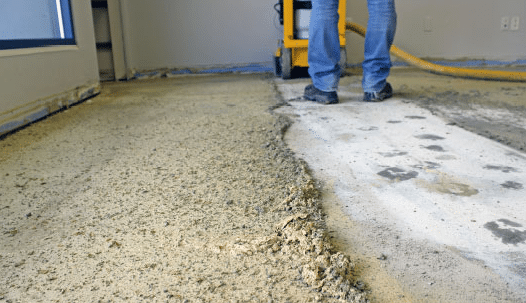Polished Concrete Floors – Making Procedure and Benefits
Polished concrete floor surface is made by a mechanical process of grinding and polishing with the help of a penetrant chemical to provide different texture. The polishing of concrete is a multi-step process which requires specialized tools and equipment.
The chemical penetrant employed for polishing is called as hardener. The construction process, features and the benefits of making polished concrete are explained below.
How to Make Polished Concrete?
The property of polished concrete is obtained through a surface effect. There are several ways to bring this surface effect of polished finished look. Whatever be the method chosen, the basic approach is the same.

1. Grinding Process
For polishing concrete surfaces, machines that are equipped with diamond segmented abrasives is employed. These machines help to grind down the concrete surfaces till the desired shine and smoothness is achieved.

As the grinding process proceeds, the coarser grit moves to finer-grits. Grits here is defined as the particle size of the diamond. Most of the concrete grinding process starts from a value less than 100. The machines available in the market have grinding discs with different grits.
2. Concrete Polishing Methods
The concrete can be polished by two methods, namely:
- Wet Method
- Dry Method
1. Wet Method of Polishing Concrete
In the wet method of polishing concrete, during the grinding process, water is used to cool the diamond abrasives. This hence reduces the amount of dust created during the polishing process. The water used in wet polishing method helps to reduce the friction. This water also acts as a lubricant, thus increasing the life of the polishing abrasives.

As water is used throughout the process, a huge amount of slurry is formed. This creates difficulty in cleaning and disposal.
2. Dry Method of Polishing Concrete
In case of a dry polishing method, no water used during the process. To the floor polisher, a containment system is attached so that the dust formed is directly taken through this arrangement through vacuum effect. This clears the mess along with the process. This is an added advantage over wet polishing method.
The dry method is used commonly in industrial floor polishing as it is more convenient, fast and environmentally friendly.
Procedure to Polish Concrete
The step by step procedure to obtain a polished concrete are:
- The first step is to prepare the concrete surface by grinding. The concrete surface to be polished is prepared by removing the existing coatings over it. This can be performed by using a diamond abrasive of 16 to 20 grit. This must be the tool that is specifically used to remove coatings.
- If cracks or joints are present on the concrete surface, it must be sealed by means of fillers (semi-grid) or epoxies.
- Once sealed, the surface is grind with the diamond abrasives. The grit used can range from 30 to 40. A metal bonded diamond is used. This is followed by a metal bonded diamond grinding of 80 grit. Then with a 150 grit metal bonded diamond.
- After the series of grinding, the surface is densified by applying a chemical hardener.
- Polishing is performed by means of a resin bond diamond with grit varying from 100 to 200. A combination of both can also be used.
- Next polishing is performed by a 400 grit followed by an 800 grit resin bond diamond.
- The final finishing is performed by a 1500 or a 3000 grit resin-bond diamond.
- In order to maintain the surface, a coat of stain guard over the concrete surface is recommended.
Note: The different levels of grit values chosen depends on the smoothness and polish required by the manufacturer or the owner for the concrete surface.
Benefits of Polished Concrete
- High durability
- Creates non-slippery surface as it has a high coefficient of friction
- Low maintenance
- Insect attack and mold growth are not encouraged
- Helps improve natural lighting
- Use the existing materials for construction, hence are sustainable
- Polished concrete can be easily cleaned by water or neutral cleaners
- Polished concrete can withstand extreme industrial environments
- The concrete surface is improved by polishing
- The appearance of the concrete surface is improved
- 3D forms can be easily achieved by concrete polishing compared with natural stone.
I read a lot of stuff and i found that the way of writing to clarifying efficient installation and maintenance services. Concrete patios Virginia Beach
ReplyDelete